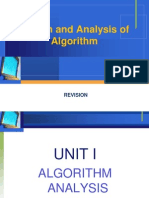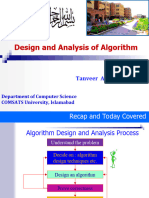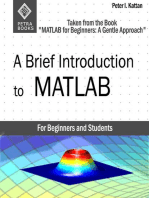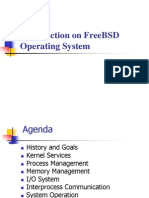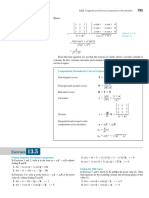Dynamic Programming1
Uploaded by
Mohammad Bilal MirzaDynamic Programming1
Uploaded by
Mohammad Bilal Mirza1
Chapter 15
Dynamic Programming
2
Introduction
Optimization problem: there can be many possible solution.
Each solution has a value, and we wish to find a solution
with the optimal (minimum or maximum) value
Dynamic Programming VS. Divide-and-Conquer
Solve problems by combining the solutions to sub-problems
The sub-problems of D-A-C are non-overlap
The sub-problems of D-P are overlap
Sub-problems share sub-sub-problems
D-A-C solves the common sub-sub-problems repeatedly
D-P solves every sub-sub-problems once and stores its
answer in a table
Programming refers to a tabular method
3
Development of A Dynamic-
Programming Algorithm
Characterize the structure of an optimal solution
Recursively define the value of an optimal solution
Compute the value of an optimal solution in a bottom-up
fashion
Construct an optimal solution from computed information
4
Assembly-Line Scheduling
5
Problem Definition
e
1
, e
2
: time to enter assembly lines 1 and 2
x
1
, x
2
: time to exit assembly lines 1 and 2
t
i,j
: time to transfer from assembly line 12
or 21
a
i,j
: processing time in each station
Time between
adjacent stations
are 0
2
n
possible solutions
6
7
Step 1
The structure of the fastest way through the factory (from
the starting point)
The fastest possible way through S
1,1
(similar for S
2,1
)
Only one way take time e
1
The fastest possible way through S
1,j
for j=2, 3, ..., n (similar for S
2,j
)
S
1,j-1
S
1,j
: T
1,j-1
+ a
1,j
If the fastest way through S
1,j
is through S
1,j-1
must have
taken a fastest way through S
1,j-1
S
2,j-1
S
1,j
: T
2,j-1
+ t
2,j-1
+ a
1,j
Same as above
An optimal solution contains an optimal solution to sub-
problems optimal substructure (Remind: D-A-C)
8
S1,1 2 + 7 = 9
S2,1 4 + 8 = 12
9
S1,1 2 + 7 = 9
S2,1 4 + 8 = 12
S1,2 =
S1,1 + 9 = 9 + 9 = 18
S2,1 + 2 + 9 = 12 + 2 + 9 = 23
S2,2 =
S1,1 + 2 + 5 = 9 + 2 + 5 = 16
S2,1 + 5 = 12 + 5 = 17
10
S1,2 18
S2,2 16
S1,3 =
S1,2 + 3 = 18 + 3 = 21
S2,2 + 1 + 3 = 16 + 1 + 3 = 20
S2,3 =
S1,2 + 3 + 6 = 16 + 3 + 6 = 25
S2,2 + 6 = 16 + 6 = 22
11
Step 2
A recursive solution
Define the value of an optimal solution recursively in terms of the
optimal solution to sub-problems
Sub-problem here: finding the fastest way through station j on both
lines
f
i
[j]: fastest possible time to go from starting pint through S
i,j
The fastest time to go all the way through the factory: f*
f* = min(f
1
[n] + x
1
, f
2
[n] + x
2
)
Boundary condition
f
1
[1] = e
1
+ a
1,1
f
2
[1] = e
2
+ a
2,1
12
Step 2 (Cont.)
A recursive solution (Cont.)
The fastest time to go through S
i,j
(for j=2,..., n)
f
1
[j] = min(f
1
[j-1] + a
1,j
, f
2
[j-1] + t
2,j-1
+ a
2,j
)
f
2
[j] = min(f
2
[j-1] + a
2,j
, f
1
[j-1] + t
1,j-1
+ a
2,j
)
l
i
[j]: the line number whose station j-1 is used in a fastest way
through S
i,j
(i=1, 2, and j=2, 3,..., n)
l* : the line whose station n is used in a fastest way through the
entire factory
13
Step 3
Computing the fastest times
you can write a divide-and-conquer recursive algorithm now...
But the running time is O(2
n
)
r
i
(j) = the number of recurrences made to f
i
[j] recursively
r
1
(n) = r
2
(n) =1
r
1
(j) = r
2
(j) = r
1
(j+1) + r
2
(j+1) r
i
(j) =2
n-j
Observe that for j>2, f
i
[j] depends only one f
1
[j-1] and f
2
[j-1]
compute f
i
[j] in order of increasing station number j and store f
i
[j]
in a table
O(n)
14
15
16
Step 4
Constructing the fastest way through the factory
line 1, station 6
line 2, station 5
line 2, station 4
line 1, station 3
line 2, station 2
line 1, station 1
17
Elements of Dynamic
Programming
Optimal substructure
Overlapping subproblems
18
Optimal Substructure
A problem exhibits optimal substructure if an optimal
solution contains within it optimal solutions to subproblems
Build an optimal solution from optimal solutions to subproblems
Example
Assembly-line scheduling: the fastest way through station j of either
line contains within it the fastest way through station j-1 on one line
Matrix-chain multiplication: An optimal parenthesization of A
i
A
i+1
A
j
that splits the product between A
k
and A
k+1
contains within it optimal
solutions to the problem of parenthesizing A
i
A
i+1
A
k
and
A
k+1
A
k+2
A
j
19
Common Pattern in Discovering
Optimal Substructure
Show a solution to the problem consists of making a choice.
Making the choice leaves one or more subproblems to be
solved.
Suppose that for a given problem, the choice that leads to
an optimal solution is available.
Given this optimal choice, determine which subproblems
ensue and how to best characterize the resulting space of
subproblems
Show that the solutions to the subproblems used within the
optimal solution to the problem must themselves be optimal
by using a cut-and-paste technique and prove by
contradiction
20
Illustration of Optimal
SubStructure
A
1
A
2
A
3
A
4
A
5
A
6
A
7
A
8
A
9
Suppose ((A
7
A
8
)A
9
) is optimal ((A
1
A
2
)(A
3
((A
4
A
5
)A
6
)))
Minimal
Cost_A
1..6
+ Cost_A
7..9
+p
0
p
6
p
9
(A
3
((A
4
A
5
)A
6
)) (A
1
A
2
) Then must be optimal for A
1
A
2
A
3
A
4
A
5
A
6
Otherwise, if ((A
4
A
5
)A
6
) (A
1
(A
2
A
3
)) is optimal for A
1
A
2
A
3
A
4
A
5
A
6
Then ((A
1
(A
2
A
3
)) ((A
4
A
5
)A
6
)) ((A
7
A
8
)A
9
) will be better than
((A
7
A
8
)A
9
) ((A
1
A
2
)(A
3
((A
4
A
5
)A
6
)))
21
Characterize the Space of
Subproblems
Rule of thumb: keep the space as small as possible, and
then to expand it as necessary
Assembly-line scheduling: S
1,j
and S
2,j
are enough
Matrix-chain multiplication: how about A
1
A
2
A
j
?
A
1
A
2
A
k
and A
k+1
A
k+2
A
j
need to vary at both hand
Therefore, the subproblems should have the form A
i
A
i+1
A
j
22
Characteristics of Optimal
Substructure
How many subproblems are used in an optimal solution to the original
problem?
Assembly-line scheduling: 1 (S
1,j-1
or S
2,j-1
)
Matrix-chain scheduling: 2 (A
1
A
2
A
k
and A
k+1
A
k+2
A
j
)
How may choice we have in determining which subproblems to use in
an optimal solution?
Assembly-line scheduling: 2 (S
1,j-1
or S
2,j-1
)
Matrix-chain scheduling: j - i (choice for k)
Informally, the running time of a dynamic-programming algorithm relies
on: the number of subproblems overall and how many choices we look
at for each subproblem
Assembly-line scheduling: O(n) * 2 = O(n)
Matrix-chain scheduling: O(n
2
) * O(n) = O(n
3
)
23
Dynamic Programming VS.
Greedy Algorithms
Dynamic programming uses optimal substructure in a
bottom-up fashion
First find optimal solutions to subproblems and, having solved the
subproblems, we find an optimal solution to the problem
Greedy algorithms use optimal substructure in a top-down
fashion
First make a choice the choice that looks best at the time and
then solving a resulting subproblem
24
Subtleties Need Experience
Sometimes an optimal substructure does not exist
Consider the following two problems in which we are given a
directed graph G=(V, E) and vertices u, v eV
Unweighted shortest path: Find a path from u to v consisting the
fewest edges. Such a path must be simple (no cycle).
Optimal substructure? YES
We can find a shortest path from u to v by considering all
intermediate vertices w, finding a shortest path from u to w and a
shortest path from w to v, and choosing an intermediate vertex w
that yields the overall shortest path
Unweighted longest simple path: Find a simple path from u to v
consisting the most edges.
Optimal substructure? NO. WHY?
25
A
B
C
D
E
F
G
UnWeighted Shortest Path
ABEGH is optimal for A to H
Therefore, ABE must be optimal for A to E; GH must be optimal for G to H
H
I
26
No Optimal Substructure in
Unweighted Longest Simple Path
Sometimes we cannot assemble a legal solution to the problem from solutions to
subproblems (qstr + rqst = qstrqst)
Unweighted longest simple path is NP-complete: it is
unlikely that it can be solved in polynomial time
27
Independent Subproblems
In dynamic programming, the solution to one subproblem
must not affect the solution to another subproblem
The subproblems in finding the longest simple path are not
independent
qt: qr + rt
qstr: we can no longer use s and t in the second
subproblem ... Sigh!!!
28
Overlapping SubProblems
The space of subproblems must be small in the sense that a
recursive algorithm for the problem solves the same
subproblems over and over, rather than always generating
new subproblems
Typically, the total number of distinct subproblems is a polynomial in
the input size
Divide-and-Conquer is suitable usually generate brand-new
problems at each step of the recursion
Dynamic-programming algorithms take advantage of
overlapping subproblems by solving each subproblem once
and then storing the solution in a table where it can be
looked up when needed, using constant time per lookup
29
m[3,4] is computed twice
30
Comparison
31
Recursive Procedure for
Matrix-Chain Multiplication
The time to compute m[1..n] is at least exponential in n
Prove T(n) = O(2
n
) using the substitution method
Show that T(n) > 2
n-1
+ >
+ + + >
>
=
1
1
1
1
) ( 2 ) (
) 1 ) ( ) ( ( 1 ) (
1 ) 1 (
n
i
n
k
n i T n T
k n T k T n T
T
1 1
2
0
1
1
1
2 ) 2 2 ( ) 1 2 ( 2
2 2 2 2 ) (
=
> + = + =
= +
= + >
n n n
n
i
i
n
i
i
n n
n n n T
32
Reconstructing An Optimal
Solution
As a practical matter, we often store which choice we made
in each subproblem in a table so that we do not have to
reconstruct this information from the costs that we stored
Self study the costs of reconstructing optimal solutions in the cases
of assembly-line scheduling and matrix-chain multiplication, without
l
i
[j] and s[i, j] (Page 347)
33
Memoization
A variation of dynamic programming that often offers the
efficiency of the usual dynamic-programming approach
while maintaining a top-down strategy
Memoize the natural, but inefficient, recursive algorithm
Maintain a table with subproblem solutions, but the control structure
for filling in the table is more like the recursive algorithm
Memoization for matrix-chain multiplication
Calls in which m[i, j] = O(n
2
) calls
Calls in which m[i, j] < O(n
3
) calls
Turns an O(2
n
)-time algorithm into an O(n
3
)-time algorithm
34
35
LOOKUP-CHAIN(p, i, j)
if m[i, j] <
then return m[i, j]
if i=j
then m[i, j] 0
else for k i to j-1
do qLOOKUP-CHAIN(p, i, k)
+ LOOKUP-CHAIN(p, k+1, j) + p
i-1
p
k
p
j
if q < m[i, j]
then m[i, j] q
return m[i, j]
Comparison
36
37
Dynamic Programming VS.
Memoization
If all subproblems must be solved at least once, a bottom-up
dynamic-programming algorithm usually outperforms a top-
down memoized algorithm by a constant factor
No overhead for recursion and less overhead for maintaining table
There are some problems for which the regular pattern of table
accesses in the dynamic-programming algorithm can be exploited to
reduce the time or space requirements even further
If some subproblems in the subproblem space need not be
solved at all, the memoized solution has the advantage of
solving only those subproblems that are definitely required
38
Self-Study
Two more dynamic-programming problems
Section 15.4 Longest common subsequence
Section 15.5 Optimal binary search trees
You might also like
- Algorithms Analysis: Minimum and Maximum AlgNo ratings yetAlgorithms Analysis: Minimum and Maximum Alg44 pages
- Fundamentals of Algorithms 10B11CI411: Dynamic Programming Instructor: Raju PalNo ratings yetFundamentals of Algorithms 10B11CI411: Dynamic Programming Instructor: Raju Pal70 pages
- Dynamic Programming: Part 1: Intro and The Assembly-Line Scheduling ProblemNo ratings yetDynamic Programming: Part 1: Intro and The Assembly-Line Scheduling Problem14 pages
- Dynamic Programming: Fundamrntals of Computer AlgorithmsNo ratings yetDynamic Programming: Fundamrntals of Computer Algorithms33 pages
- Dynamic Programming & Assembly - Line SchedulingNo ratings yetDynamic Programming & Assembly - Line Scheduling9 pages
- COSC 3101A - Design and Analysis of Algorithms 7No ratings yetCOSC 3101A - Design and Analysis of Algorithms 750 pages
- Introduction To Dynamic Programming: 20bits About WritingNo ratings yetIntroduction To Dynamic Programming: 20bits About Writing6 pages
- Algo - Mod9 - Dynamic Programming MethodNo ratings yetAlgo - Mod9 - Dynamic Programming Method51 pages
- Dynamic Programming and Multistage Graph Both ApproachesNo ratings yetDynamic Programming and Multistage Graph Both Approaches20 pages
- A Brief Introduction to MATLAB: Taken From the Book "MATLAB for Beginners: A Gentle Approach"From EverandA Brief Introduction to MATLAB: Taken From the Book "MATLAB for Beginners: A Gentle Approach"2.5/5 (2)
- Inverse Trigonometric Functions (Trigonometry) Mathematics Question BankFrom EverandInverse Trigonometric Functions (Trigonometry) Mathematics Question BankNo ratings yet
- Trigonometric Ratios to Transformations (Trigonometry) Mathematics E-Book For Public ExamsFrom EverandTrigonometric Ratios to Transformations (Trigonometry) Mathematics E-Book For Public Exams5/5 (1)
- Nopcommerce: Presented By: Muhammad Bilal (Bilal M.) Pse Datumsquar It ServicesNo ratings yetNopcommerce: Presented By: Muhammad Bilal (Bilal M.) Pse Datumsquar It Services5 pages
- Text Figure (4.2) 1D Discrete Fourier TransformNo ratings yetText Figure (4.2) 1D Discrete Fourier Transform20 pages
- Assembly Language Programming - CS401 Power Point Slides Lecture 08No ratings yetAssembly Language Programming - CS401 Power Point Slides Lecture 0827 pages
- ACA Microprocessor and Thread Level ParallelismNo ratings yetACA Microprocessor and Thread Level Parallelism41 pages
- G52MAL: Lecture 18: Recursive-Descent Parsing: Elimination of Left RecursionNo ratings yetG52MAL: Lecture 18: Recursive-Descent Parsing: Elimination of Left Recursion26 pages
- Exercise 1: Majorization and Random Permutations: CSE 599d Quantum Computing Problem Set 1 SolutionsNo ratings yetExercise 1: Majorization and Random Permutations: CSE 599d Quantum Computing Problem Set 1 Solutions7 pages
- 1.1 The Real Number System: Types of NumbersNo ratings yet1.1 The Real Number System: Types of Numbers4 pages
- Frame Analysis Using Matrix Strutural AnalysisNo ratings yetFrame Analysis Using Matrix Strutural Analysis12 pages
- Addition Mathematic Form 5 Progression Module 1No ratings yetAddition Mathematic Form 5 Progression Module 115 pages
- Optimization Techniques and New Management ToolsNo ratings yetOptimization Techniques and New Management Tools6 pages
- IFS Matlab Generator A Computer Tool For Displaying IFS FractalsNo ratings yetIFS Matlab Generator A Computer Tool For Displaying IFS Fractals11 pages
- Fundamentals of Engineering Review For Dynamics: Dr.'s Yannitell (Retired) & DR Waggenspack Mewagg@me - Lsu.eduNo ratings yetFundamentals of Engineering Review For Dynamics: Dr.'s Yannitell (Retired) & DR Waggenspack Mewagg@me - Lsu.edu43 pages
- Parte 2 Fundamentos Electromagneticos Con Matlab - Lonngren & SavovNo ratings yetParte 2 Fundamentos Electromagneticos Con Matlab - Lonngren & Savov354 pages





















